Common name: Shiny Bush, Slate pencil plant, pepper elder, rat's ear, shiny bush, silverbush •Malayalam: Mashitandu chedi • Assamese: Pononoa • Sanskrit: Toyakandha, Varshabhoo
Botanical name: Peperomia pellucida Family: Piperaceae (Pepper family)
Synonyms: Peperomia exigua, Peperomia translucens, Piper pellicudum
Shiny bush is a common fleshy annual herb, growing by roadside and in wasteland. Stems are translucent pale green, erect or ascending, usually 15-45 cm long, internodes usually 3-8 cm long, hairless. Fleshy leaves are heart shaped, shiny light green, 1.5-4 cm long, 1-3.3 cm wide. It has very small bi-sexual flowers growing in the form of cord-like spikes, 3-6 cm long, arising from the leaf axils. The fruits are also very small, round to oblong, ridged, first green later black. They have one single seed. Shiny bush has a mustard like odor.The plant can be utilized as a vegetable and in salads. Shiny Bush is native to south America, but widely naturalized and cultivated.
Medicinal uses:  In South America, Shiny Bush is used medicinally. A solution of the fresh juice of stem and leaves is used against eye inflammation. It is also been applied against coughing, fever, common cold, headache, sore throat, diarrhea, against kidney - and prostate problems and against high blood pressure. Shiny bush is also used in Ayurvedic medicine In South America, Shiny Bush is used medicinally. A solution of the fresh juice of stem and leaves is used against eye inflammation. It is also been applied against coughing, fever, common cold, headache, sore throat, diarrhea, against kidney - and prostate problems and against high blood pressure. Shiny bush is also used in Ayurvedic medicine
Tailed Pepper
|  |
|

|
Common name: Tailed Pepper, java pepper, cubeb • Hindi: कबाब चीनी Kabab-chini, kabachini, शीतल चीनी Sheetal-chini • Kannada: Balmenasu, Gandha menasu • Malayalam: Val-milaku • Marathi: Mothi, Pimpli • Oriya: Sugandhamaricha • Sanskrit: Renuka, cinatiksna, Chinorana, Kakkola • Tamil: valmilaku, kanakamilaku, takkolam • Telugu: halava-miriyalu, toka-miriyalu • Urdu: Kabab-chini, Shital-chini
Botanical name: Piper cubeba Family: Piperaceae (Pepper family)
Tailed pepper is a plant cultivated for its fruit and essential oil. It is mostly grown in Java and Sumatra, hence sometimes called Java pepper. It is a perennial plant, with a climbing stem, round branches, about as thick as a goose-quill, ash-colored, and rooting at the joints. The leaves are from 4-6.5 inches long, 1.5-2 inches broad, ovate-oblong, long pointed, and very smooth. Flowers are arranged in narrow spikes at the end of the branches. Fruit, a berry rather longer than that of black pepper. Tailed pepper is native to SE Asia, introduced in India by Arabian traders.
Medicinal uses:  Sanskrit texts included cubeb in various remedies. Charaka and Sushruta prescribed a cubeb paste as a mouthwash, and the use of dried cubebs internally for oral and dental diseases, loss of voice, halitosis, fevers, and cough. Unani physicians use a paste of the cubeb berries externally on male and female genitals to intensify sexual pleasure during coitus. Due to this attributed property, cubeb was called "Habb-ul-Uruus". Sanskrit texts included cubeb in various remedies. Charaka and Sushruta prescribed a cubeb paste as a mouthwash, and the use of dried cubebs internally for oral and dental diseases, loss of voice, halitosis, fevers, and cough. Unani physicians use a paste of the cubeb berries externally on male and female genitals to intensify sexual pleasure during coitus. Due to this attributed property, cubeb was called "Habb-ul-Uruus".
Long Pepper
|  |
|
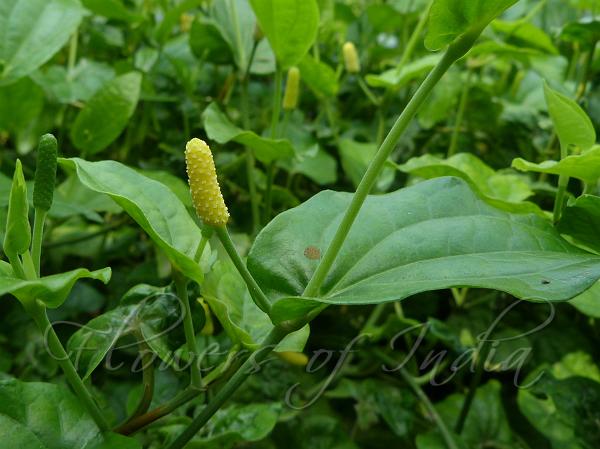
|
Common name: Long Pepper, Indian long pepper • Hindi: पिपली Pipli • Marathi: पिंपळी Pimpli • Tamil: திப்பிலீ Tippili • Malayalam: തിപ്പലീ Tippali • Telugu: Pippallu • Kannada: Kandan Lippili • Konkani: पिपली Pipli • Urdu: Pipul پیپل • Gujarati: પીપરી Pipari • Sanskrit: पिप्पली Pippali, Magadhi
Botanical name: Piper longum Family: Piperaceae (Pepper family)
Long Pepper is a climber, of South Asian origin (Deccan peninsula), cultivated for its fruit, which is usually dried and used as a spice and seasoning. Long pepper is a close relative of the black pepper plant, and has a similar, though generally hotter, taste. The word pepper itself is derived from the Sanskrit word for long pepper, pippali. It is a slender, aromatic, climber with perennial woody roots, creeping and jointed stems, and fleshy fruits embedded in the spikes. Leaves are numerous, 6.3 to 9.0 cm, broadly ovate or oblong-oval, dark green and shining above, pale and dull beneath. The older leaves are dentate, dark in color and heart shaped. The younger leaf is ovate in shape and contains 5 veins on them. Flowers are monoceous and male and female flowers are borne on different plants. Male flower stalk is about 1 to 3 inch long and female flower stalk is ½ to 1 inch long. Fruit is long. When it ripes it attains red color and when it dries it attains black color. It is one inch in diameter. The plant flowers in rains and fruits in early winters.
Medicinal uses:  Pippali is certainly one of the most widely used of all Ayurvedic herbs. It is one of the best herbs for enhancing digestion, assimilation and metabolism of the foods we eat. It is also highly prized for its ability to enhance assimilation and potency of herbs in a synergistic formula (this is called the Yogavahi effect). Pippali is certainly one of the most widely used of all Ayurvedic herbs. It is one of the best herbs for enhancing digestion, assimilation and metabolism of the foods we eat. It is also highly prized for its ability to enhance assimilation and potency of herbs in a synergistic formula (this is called the Yogavahi effect).
Cow-Foot Leaf
|  |
|
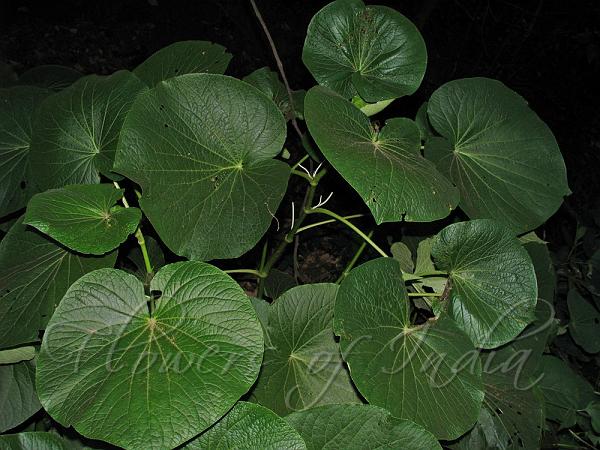
|
Common name: Cow-Foot Leaf
Botanical name:  Piper umbellatum Family: Piperaceae (Pepper family) Piper umbellatum Family: Piperaceae (Pepper family)
Synonyms: Lepianthes umbellata, Piper subpeltatum, Pothomorphe alleni
Cow-Foot Leaf is an erect, somewhat woody plant, 1-2 m tall. Leaves are membranaceous with prominent, glandular, brown to black dots beneath, broadly ovate to suborbicular-ovate, 17-37 cm long, 15-32 cm wide, the base subpeltate, multiplinerved and equilaterally deeply heart-shaped, the tip with a pointed tip, somewhat hairy on the nerves on both surfaces, and the margins ciliate. Leaf-stalks are very long, more or less hairy, 11.5-27.5 cm long. Spikes are numerous, umbellate, axillary, hermaphroditic, 5.5-12 cm long, 2-3.5 mm in diameter. Rachis is smooth. Bracts are stalked, peltate, about 1 mm long, with semilunar, triangular disk. Fruit is free, crowded, obovoid-trigonous, 0.75-1 mm long, about 0.5 mm in diameter, glandular, with the apex truncate and umbonate. Stigmas are cuspidate. Stamens are two, 0.2 mm long and with very short stalks. Cow-Foot Leaf is native to South America, naturalized in many parts of the world.
Medicinal uses:  In the Philippines, fresh leaves are applied on the surface of abscesses as topicals. Juice of leaves applied to eyes for conjunctivitis. In French Guiana, plant is used as remedy for tapeworms. In other countries, used as antiscorbutic and diuretic. In the Philippines, fresh leaves are applied on the surface of abscesses as topicals. Juice of leaves applied to eyes for conjunctivitis. In French Guiana, plant is used as remedy for tapeworms. In other countries, used as antiscorbutic and diuretic.
Identification credit: Shrikant Ingalhalikar
Nepal Yam
|  |
|
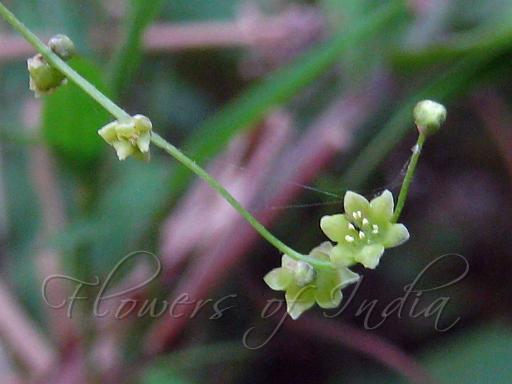
|
Common name: Nepal Yam • Hindi: Shingli-mingli, Baniatakari, Harvish, Janj, Jung kinch • Nepali: भ्याकुर तरुल Bhyakur tarul
Botanical name:  Dioscorea deltoidea Family: Dioscoreaceae (Yam family) Dioscorea deltoidea Family: Dioscoreaceae (Yam family)
Synonyms: Tamus nepalensis, Dioscorea nepalensis
Nepal Yam is a hairless vine, twining clockwise. Tubers are ligneous, irregular. Alternately arranged leaves are simple, 5-11.5 cm long, 4-10.5 cm broad, ovate or triangular-ovate, often heart-shaped, the basal lobes rounded or sometimes dilated outwards, 7-9-nerved, long-pointed, hairless above, velvety on the nerves beneath. Leaf-stalks are 5-10 cm long, slender. Male flower spikes occur solitary in leaf axils, simple or sometimes branched, slender, lax, 7.5-25 cm long. Flowers are in small distant clusters; stamens 6, antheriferous. Female spikes are solitary, slender, up to 15 cm long, few-flowered. Capsule is 2 cm long, 3 cm broad, obovate or obcordate. Seeds are winged unequally all round. Nepal Yam is found in the Himalayas, from Kashmir to Assam, Indo-China and W. China, at altitudes of 450-3100 m. Flowering: May-July.
Medicinal uses:  The juice of the root tuber istaken in the evening in the treatment of roundworm. It is also used to alleviate constipation. The roots of most, if not all, members of this genus, contains diosgenin. This is widely used in modern medicine in order to manufacture progesterone and other steroid drugs. These are used as contraceptives and in the treatment of various disorders of the genitary organs as well as in a host of other diseases such as asthma and arthritis. The roots of this species contain an average of 4.8% diosgenin. The juice of the root tuber istaken in the evening in the treatment of roundworm. It is also used to alleviate constipation. The roots of most, if not all, members of this genus, contains diosgenin. This is widely used in modern medicine in order to manufacture progesterone and other steroid drugs. These are used as contraceptives and in the treatment of various disorders of the genitary organs as well as in a host of other diseases such as asthma and arthritis. The roots of this species contain an average of 4.8% diosgenin.
Wild Yam
|  |
|

|
Common name: Wild Yam, Colic Root
Botanical name: Dioscorea villosa Family: Dioscoreaceae (Yam family)
Synonyms: Dioscorea glauca, Dioscorea hirticaulis, Dioscorea quaternata
Native to North America, Wild Yam is a perennial vine which can reach a height of 10 ft. The stem is slender, rarely branched and tends to twine right to left or counterclockwise. Alternately arranged leaves are heart- shaped. The lowest leaves may appear whorled. Leaves have 7-11 parallel veins, and may be hairy on the underside. Wild yam has separate male and female flowers, yellow-green, in loose straggling clusters. Female flowers sit on top of winged green fruits. Flowering time: June-August.
Medicinal uses:  Native Americans and early herbalist had many uses for this plant including the treatment of many female and childbirth related problems. It was also used to treat various gastrointestinal problems, muscle spasms, various painful conditions such as arthritis and rheumatism. There seems to be no scientific evidence of its effectiveness for these conditions. Nonetheless, plants of this genus are valuable to modern medicine. Many of our modern steroids are manufactured from diosgenin extracted from them. Native Americans and early herbalist had many uses for this plant including the treatment of many female and childbirth related problems. It was also used to treat various gastrointestinal problems, muscle spasms, various painful conditions such as arthritis and rheumatism. There seems to be no scientific evidence of its effectiveness for these conditions. Nonetheless, plants of this genus are valuable to modern medicine. Many of our modern steroids are manufactured from diosgenin extracted from them.
Fiji Arrowroot
|  |
|
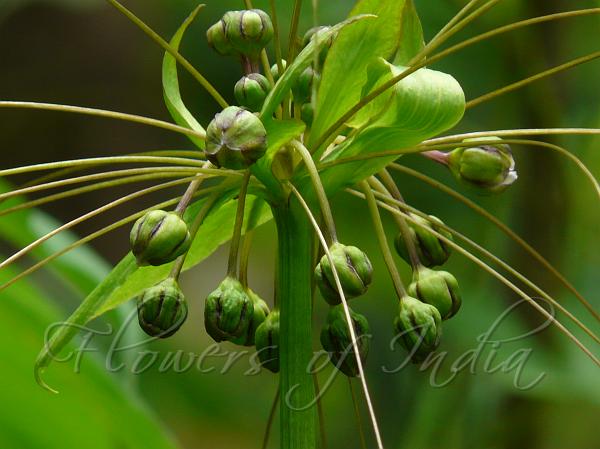
|
Common name: Fiji Arrowroot, batflower, East Indian arrowroot, Polynesian arrowroot, Tahiti arrowroot • Hindi: बाघ मूंछ Bagh-moochh, देवकन्द devkanda • Marathi: देवकंद devkanda • Tamil: சேனை cenai, ககனம் kakanam, காறாக்கருணை kattu-k-karunai • Telugu: అడవిదుంప adavidumpa
Botanical name: Tacca leontopetaloides Family: Dioscoreaceae (Yam family)
Synonyms: Tacca hawaiiensis, Tacca involucrata, Tacca pinnatifida
Fiji Arrowroot is a perennial herb naturally distributed from western Africa through southeast Asia to northern Australia. The leaf's upper surface has depressed veins, and the under surface is shiny with bold yellow veins. Greenish purple flowers are borne on tall stalks in clusters, with long trailing whisker-like bracts. The plant is usually dormant for part of the year and dies down to the ground. Later, new leaves will arise from the round underground tuber. The tubers are hard and potato-like, with a brown skin and white interior. The tubers of Polynesian arrowroot contain starch that was an important food source for many Pacific Island cultures, primarily for the inhabitants of low islands and atolls. Polynesian arrowroot was prepared into a flour to make a variety of puddings.
Medicinal uses:  In traditional Hawaiian medicine the raw tubers were eaten to treat stomach ailments. Mixed with water and red clay, the plant was consumed to treat diarrhea and dysentery. This combination was also used to stop internal hemorrhaging in the stomach and colon and applied to wounds to stop bleeding. In traditional Hawaiian medicine the raw tubers were eaten to treat stomach ailments. Mixed with water and red clay, the plant was consumed to treat diarrhea and dysentery. This combination was also used to stop internal hemorrhaging in the stomach and colon and applied to wounds to stop bleeding.
Jewels of Opar
|  |
|
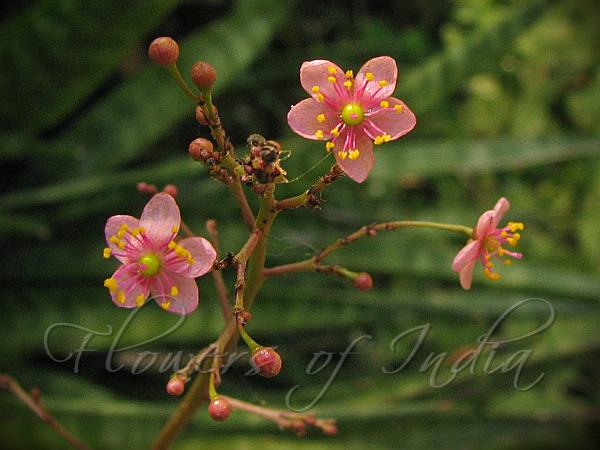
|
Common name: Jewels of Opar, Panicled Fameflower
Botanical name:  Talinum paniculatum Family: Dioscoreaceae (Yam family) Talinum paniculatum Family: Dioscoreaceae (Yam family)
Synonyms: Talinum patens, Portulaca patens
Jewels of Opar is a somewhat succulent herb, up to 3 ft tall, growing from tuberous roots. Leaves are elliptic to obovate, up to 12 cm long, much smaller below the inflorescence, slightly fleshy. Flowers are borne in lax, many-flowered branched inflorescences, bright pink, up to about 1.2 cm in diameter. Fruit a glossy dark red capsule, 3-5 mm in diameter. The individual flowers, on airy stalks, are small, but are nice massed together, especially with the red bead-like buds and fruits. A favorite with bees. jewels of Opar is native to Africa.
Medicinal uses:  Naturalized globally, Jewels of Opar has a long Chinese medicinal history. Sweet and neutral, used for loss of energy, and problems associated with lungs and spleen. Naturalized globally, Jewels of Opar has a long Chinese medicinal history. Sweet and neutral, used for loss of energy, and problems associated with lungs and spleen.
Crested Coelogyne
|  |
|
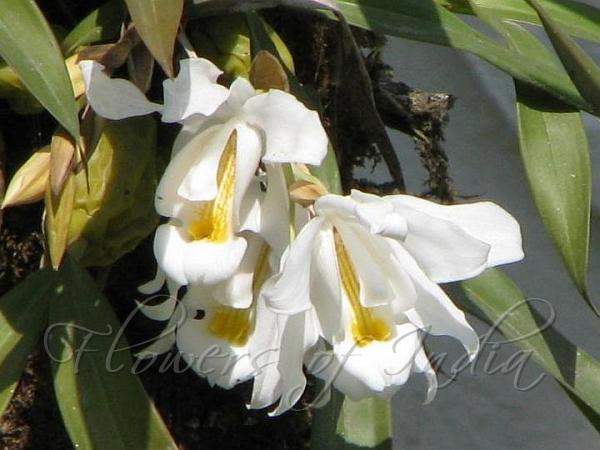
|
Common name: Crested Coelogyne • Hindi: Gondya • Nepali: Chandi gabha
Botanical name: Coelogyne cristata Family: Orchidaceae (Orchid family)
Crested Coelogyne is a very common orchid found growing on forest trees in the Himalayas, from Uttarakhand to Sikkim, at altitudes of 1000-2000 m. Joseph Hooker, who collected orchids and other plants in 1848-1850, recorded that "On the ascent from Darjeeling the straight shafts of many of the timber trees are literally clothed with a continuous garment of white-flowered coelogynes, which bloom in a profuse manner, whitening their trunks like snow". Flowers are white, in hanging clusters, with a white lip with 4 yellow ridges at the base between the lateral lobes, and with 2 broad crenulate yellow plates on the mid-lobe. Flowers are 5-9 cm across, borne in 3-10 flowered clusters 15-20 cm long. Sepals and petals are 4-5 cm long, oblong blunt with wavy margins. Bracts are oblong and persistent. Spur is absent. Leaves are paired, linear-lanceshaped 15-30 cm long, 2-3 cm broad. Pseudobulbs are oblong ovoid, 5-8 cm, arising from a stout rhizome. Flowering: March-April.
Medicinal uses:  Juice of the pseudobulb is applied to boils. This juice is also put in the wound on the hooves of animals. Juice of the pseudobulb is applied to boils. This juice is also put in the wound on the hooves of animals.
Himalayan Marsh Orchid
|  |
|
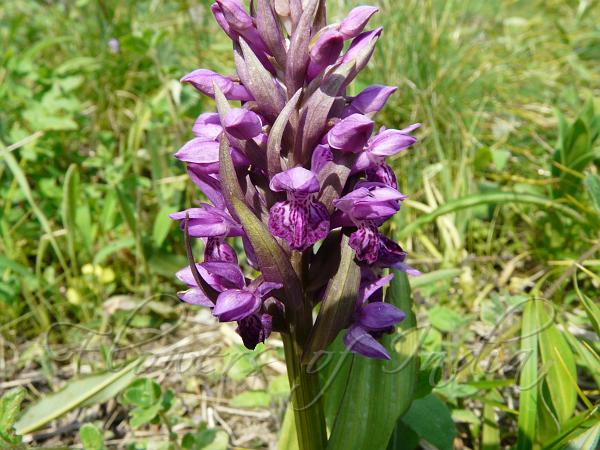
|
Common name: Himalayan Marsh Orchid, Marsh Orchis, Spotted Heart Orchid • Kumaon: Hatajari •Kashmiri: Salem Panja • Ladakhi: ཨམབོལཀཔཨ Ambolakpa • Urdu: Salap • Nepali: पाँच आँवले Panch aonle
Botanical name:  Dactylorhiza hatagirea Family: Orchidaceae (Orchid family) Dactylorhiza hatagirea Family: Orchidaceae (Orchid family)
Synonyms: Orchis latifolia var. indica
Himalayan Marsh Orchid is a medicinal herb which is now considered critically endangered. It is a perennial herb with erect, leafy, stout and hollow stem. Leaves are oblong-lance-shaped, with sheathing base. Pink purple flowers are borne in an upright spike. Flowers are purple and the bracts green, narrowly lance-shaped, lower longer than the flowers, upper slightly shorter. Flowers are about 1.8 cm long, including the curved spur. Sepals and petals are nearly equal. Three of them form a hood, and the two side sepals spread outwards. The lip is rounded and shallowly 3-lobed, spotted dark purple. Marsh Orchis is found in shrubberies, open slopes and marshes, in the Himalayas, from Pakistan to SE Tibet, at altitudes of 2800-4000 m. Flowering: June-July. Roots are tuberous, divided into 2 or 3 lobes.
Medicinal uses:  The tuber yields salap and is reputed as expectorant, aphrobisiac and as nervine tonic. Locally it is used as a nervine tonic and aphrodisiac. The tuber yields salap and is reputed as expectorant, aphrobisiac and as nervine tonic. Locally it is used as a nervine tonic and aphrodisiac.
Tiny Dendrobium
|  |
|
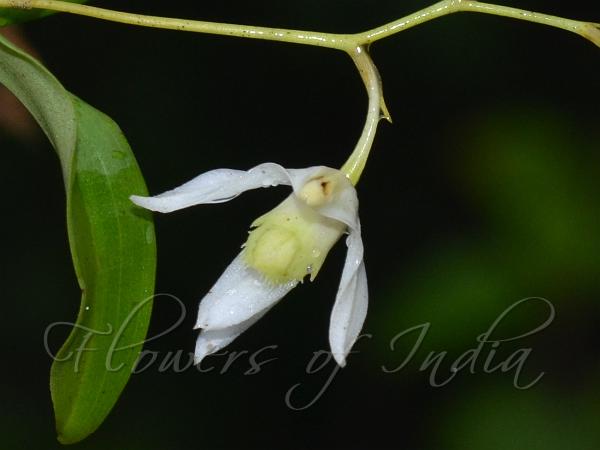
|
Common name: Tiny Dendrobium • Marathi: जांभळी दांडेअमरी Jambhli dande amri
Botanical name: Dendrobium microbulbon Family: Orchidaceae (Orchid family)
Tiny Dendrobium is a small epiphytic rare orchid native to peninsular India, which can be often seen growing out of bark of trees. Pseudobulbs are small, crowded, ovoid. The plant has 2 leaves which are linear-oblong and pointed. Flowering stem is leafless, solitary, erect, 4-8 flowered. Bracts are nearly as long as the stalk. Flowers are white, tinged with purple. They are small, about 1-1.2 cm across, stalked. Lateral sepals are obtuse, petals narrowly nearly spoon-shaped, mentum long incurved , lip thick, side lobes broad acute, midlobe small round crenulate, disk with a channelled ridge thickened at the end .
Medicinal uses:  Tiny Dendrobium is used in stomachache by the tribal people of Gujarat. Tiny Dendrobium is used in stomachache by the tribal people of Gujarat.
Identification credit: Dinesh Valke
Jeevak
|  |
|
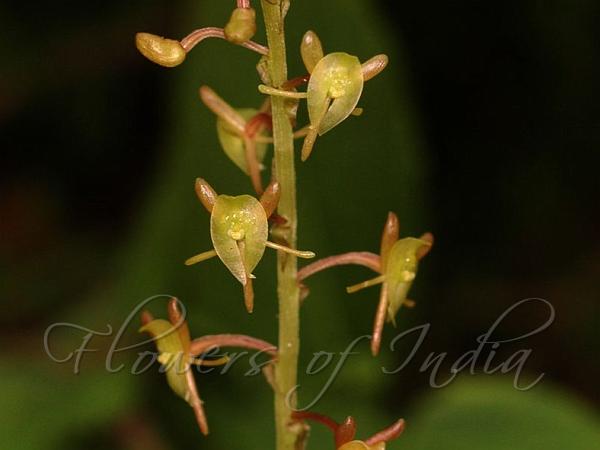
|
Common name: Jeevak • Hindi: जीवक Jivak • Tamil: ஜீவகம் Jivakam • Malayalam: ജീവകമ് Jivakam • Telugu: జీవకము Jivakamu • Kannada: ಜೀವಕ Jivaka • Sanskrit: जीवक Jivakah
Botanical name: Malaxis acuminata Family: Orchidaceae (Orchid family)
Synonyms: Microstylis wallichii
Found in India, China, and South-East Asia, at elevations up to to 1400 m, Jeevak is a small to medium sized, hot to warm growing terrestrial or lithophytic orchid. It occurs on highly eroded, stratified limestone cliffs and bluffs with horizontal rhizomes giving rise to rather thin, short stems, each bearing 3-5 , broadly lance-like, acuminate and acute, leaves. The plant blooms in summer on an erect, 4-12 inches long, several to many flowered inflorescence with lanceolate acute floral bracts. Flowers minute, pale-yellowish green, tinged with purple, in terminal racemes. Sides of the lip produced upwards into auricles, apex notched.
Medicinal uses:  The pseudobulbs are sweet, refrigerant, aphrodisiac, febrifuge and tonic. They are useful in haematemesis, fever, seminal weakness, burning sensations, dipsia, emaciation, tuberculosis and general debility. The pseudobulbs are sweet, refrigerant, aphrodisiac, febrifuge and tonic. They are useful in haematemesis, fever, seminal weakness, burning sensations, dipsia, emaciation, tuberculosis and general debility.
Edgeworth's Habenaria
|  |
|

|
Common name: Edgeworth's Habenaria • Hindi: ऋद्धि Riddhi • Tamil: Riddhi • Malayalam: Riddhi •Telugu: Riddhi • Kannada: Riddhi • Sanskrit: ऋद्धि Riddhi
Botanical name:  Platanthera edgeworthii Family: Orchidaceae (Orchid family) Platanthera edgeworthii Family: Orchidaceae (Orchid family)
Synonyms: Habenaria edgeworthii
Edgeworth's Habenaria is a tuberous terrestrial orchid, growing up to 75 cm tall. It has somewhat twisted leafy stem covered with hairs. Leaves are sheathed, 2-4 in number, ovate to lance-shaped. Flowers are yellowish green deflexed in buds, in cylindrical spike. Lip is bright yellow, entire, strap-shaped, base forming slightly channeled claw, spur longer than ovary, spreading and directed upwards usually hooked downwards towards the tip, column 2-3 mm in height. Edgeworth's Habenaria is found in the Himalayas, from Uttarkhand to Nepal, at altitudes of 2500-3000 m.
Medicinal uses:  The tubers of Edgeworth's Habenaria are used in Ayurvedic medicine. The medicine goes by the name Riddhi. The tubers of Edgeworth's Habenaria are used in Ayurvedic medicine. The medicine goes by the name Riddhi.
Kumarika
|  |
|

|
Common name: Kumarika • Hindi: कुमारिका Kumarika, Jangli aushbah, Bhitura • Mizo: Kaitha •Marathi: घोटवेल Ghotvel • Tamil: ayadi, malaittamarai, tirunamappalai, kal tamarai • Malayalam: kaltamara, karivilanti • Telugu: Kondadantena • Kannada: kaadu hambu, kaadu hambu thaavare •Bengali: কুমাৰিকা Kumarika • Oriya: mootrilata • Sanskrit: Vanamadhusnahi
Botanical name: Smilax ovalifolia Family: Smilacaceae (Smilax family)
Synonyms: Smilax macrophylla, Smilax zeylanica
Kumarika is an armed or unarmed climber. Leaves leathery, shining, 7-15 x 4-11 cm, broadly ovate to elliptic, base rounded or shortly wedge-shaped; 3-5-nerved. Leaf stalk 1.5 cm long, base sheathing, with tendrils at the end. Flowers white, in dense umbels in leaf axils, 1-3 on a common peduncle. Bracts ovate. Perianth recurved in mature flowers, outer 3 segments, 4 mm long, oblong, inner narrower. Stamens about as long as the perianth. It is found from the Himalayan region in the north to Peninsular India. Flowering: January-April.
Medicinal uses:  The roots of Kumarika are used for veneral diseases. Also applied in rheumatic swellings and given in urinary complaints and dysentery. The roots of Kumarika are used for veneral diseases. Also applied in rheumatic swellings and given in urinary complaints and dysentery.
Malabar Chlorophytum
|  |
|
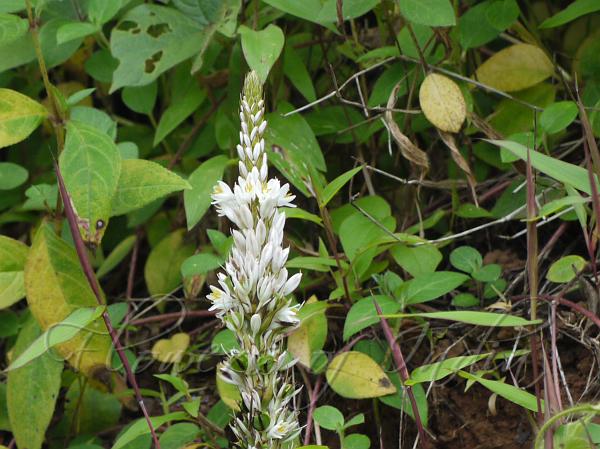
|
Common name: Malabar Chlorophytum • Hindi: सफ़ेद मुसली safed musli • Marathi: सफेत मुसळी safet musli
Botanical name: Chlorophytum malabaricum Family: Liliaceae (Lily family)
Malabar Chlorophytum is a species of Chlorophytum found in the Western Ghats. White flowers arise in an erect spike. It is medicinally used in similar ways as some other Chlorophytum species.
White Himalayan Lily
|  |
|
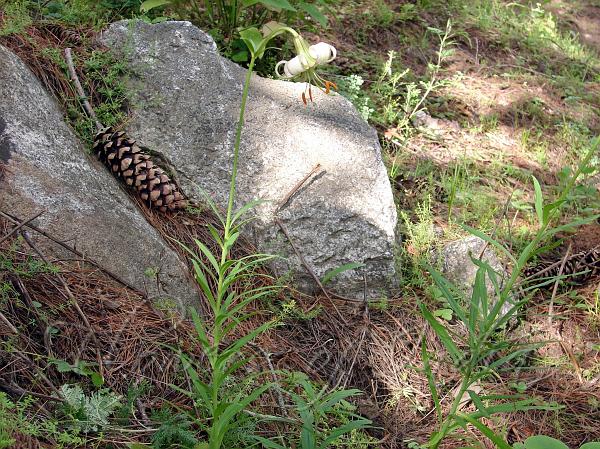
|
Common name: White Himalayan Lily, Many-leaved lily • Hindi: kalihari, क्षीरकाकोली ksirakakoli •Kannada: ksirakakoli • Malayalam: ക്ഷീരകാകൊലീ ksirakakoli • Sanskrit: kakoli, क्षीरकाकोली ksirakakoli • Tamil: ksirakakoli • Telugu: ksirakakoli
Botanical name:  Lilium polyphyllum Family: Liliaceae (Lily family) Lilium polyphyllum Family: Liliaceae (Lily family)
White Himalayan Lily is a rare Himalayan lily with 1-10 pendant, fragrant, large, waxy, bell shaped with the lower half of the tepals strongly recurved. Tepals are white or pink with many dark pink or purple spots and stripes. Anthers are large, yellow to orange. Stem is 2-4 ft tall, stiff. Leaves are small, lanceshaped, scattered. Bulb is long and narrow, white, forming long roots - it is said to grow up to 60 cm deep in the soil. The three angled capsule is 4-7 cm long with many winged seeds. White Himalayan Lily is found in the Himalayas, from Afghanistan to Nepal, at altitudes of 1800-3700 m. Flowering: June-July.
Medicinal uses:  The tuberous roots are used as a tonic in emaciation and as a source of energy, after dry roasting. The tuberous roots are used as a tonic in emaciation and as a source of energy, after dry roasting.
Golden Eye Grass
|  |
|
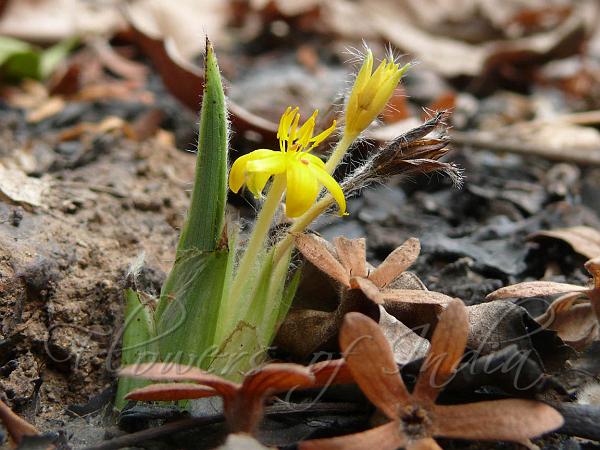
|
Common name: Golden Eye Grass, Orchid palm grass • Hindi: Kali musli काली मुसली • Oriya: Tala-muli • Kannada: Nela tengu • Malayalam: Nelppana • Tamil: நிலப்பனைக்கிழங்கு Nilappanaikkilanku • Bengali: Talamuli
Botanical name: Curculigo orchioides Family: Hypoxidaceae (Star Grass family)
Synonyms: Curculigo ensifolia, Curculigo brevifolia, Hypoxis orchioides
Golden Eye Grass is a herbaceous tuberous perennial with a short or elongate root stock bearing several fleshy lateral roots. The plant can grow up to 10-35 cm tall. Leaves sessile or petiolate 15-45x1.3-2.5 cm, linear or linear lanceolate, tips sometimes rooting, scape very short, clavate. It has hardy leaves and can take shade: the leaves will just get a bit longer in the shade than in full sun shine. During flowering period it open a golden yellow flower at the leaf base every day. This can form a cute miniature plant pot in your room. Flowering: July-August.
Medicinal uses:  The rhizomes of the plants are used for the treatment of decline in strength, jaundice and asthma. According to Ayurveda, root is heating, aphrodisiac, alternative, appetizer, fattening and useful in treatment of piles, biliousness, fatigue, blood related disorders etc. According to Unani system of medicine, root is carminative, tonic, aphrodisiac, antipyretic and useful in bronchitis, ophthalmia, indigestion, vomiting, diarrhea, lumbago, gonorrhea, gleet, hydrophobia, joint pains etc. The rhizomes of the plants are used for the treatment of decline in strength, jaundice and asthma. According to Ayurveda, root is heating, aphrodisiac, alternative, appetizer, fattening and useful in treatment of piles, biliousness, fatigue, blood related disorders etc. According to Unani system of medicine, root is carminative, tonic, aphrodisiac, antipyretic and useful in bronchitis, ophthalmia, indigestion, vomiting, diarrhea, lumbago, gonorrhea, gleet, hydrophobia, joint pains etc.
Identification credit: Rahul Prabhu Khanolkar
Krantz Aloe
|  |
|
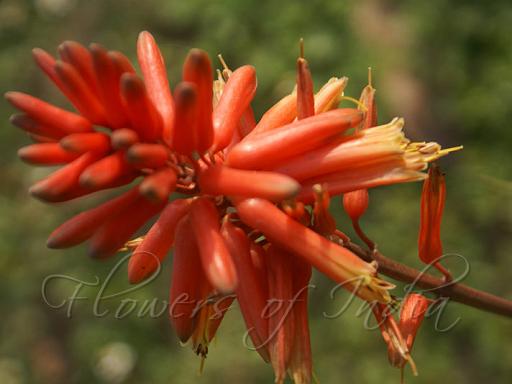
|
Common name: Krantz Aloe, Tree Aloe, Candelabra Aloe
Botanical name:  Aloe arborescens Family: Asphodelaceae (Aloe family) Aloe arborescens Family: Asphodelaceae (Aloe family)
Krantz Aloe is a large treelike multi-headed shrub. The common name krantz aloe refers to its habitat, a krantz being a rocky ridge or cliff. The species name arborescens is due to its stem forming habit. Typical height for this species ranges from 2-3 m. Its leaves are succulent and green with a slight blue tint. Its leaves are armed with small spikes along its edges and are arranged in rosettes situated at the end of branches. Flowers are arranged in racemes. The racemes are not branched but two to several can sprout from each rosette. Flowers are cylindrical in shape and are a vibrant red-orange color. Krantz Aloe is mostly native to the south eastern coast of the African continent. It is now a popular garden plant.
Medicinal uses:  As with Aloe vera, Krantz Aloe has strongly medicinal sap. In the parts of Ecuador where it is cultivated. it is considered the first treatment for any type of scratch, bite, or burn, and is used in hospitals as a primary treatment for burns up to the third degree. The sap of Krantz Aloe contains much higher concentrations of the primary compounds present in other aloes, and this higher concentration is responsible for the faster and more effective action of the sap against skin conditions. Like the sap of all aloes, that of Krantz Aloe can be drunk as a liver and digestive tonic. As with Aloe vera, Krantz Aloe has strongly medicinal sap. In the parts of Ecuador where it is cultivated. it is considered the first treatment for any type of scratch, bite, or burn, and is used in hospitals as a primary treatment for burns up to the third degree. The sap of Krantz Aloe contains much higher concentrations of the primary compounds present in other aloes, and this higher concentration is responsible for the faster and more effective action of the sap against skin conditions. Like the sap of all aloes, that of Krantz Aloe can be drunk as a liver and digestive tonic.
Aloe Vera
|  |
|
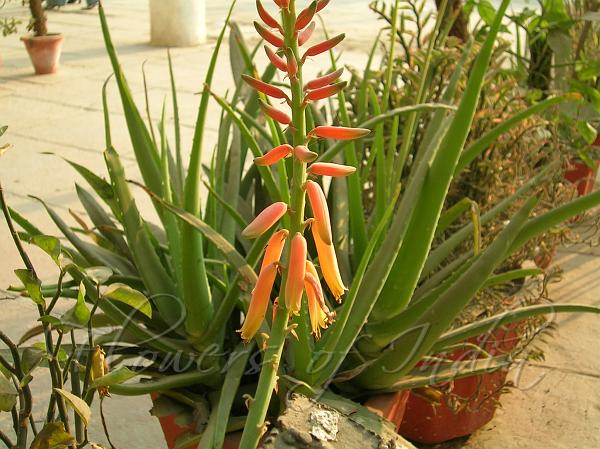
|
Common name: Aloe vera, Medicinal aloe, Burn plant • Hindi: Gheekumari घीकुमारी • Marathi: Khorpad • Tamil: கதலை Kathalai • Malayalam: Chotthu kathalai
Botanical name: Aloe vera Family: Asphodelaceae (Aloe family)
Synonyms: Aloe barbadensis, Aloe indica, Aloe vulgaris
Aloe, a popular houseplant, has a long history as a multipurpose folk remedy. Commonly known as Aloe vera, the plant can be snapped off and placed on cuts and burns for immediate relief. Aloe vera is a clump forming succulent whose fleshy gray-green leaves are arranged in a vase shaped rosette atop a very short stem. The leaves are up to 18 in long and 2 in wide at the base, slightly grooved on top, and terminating in a sharp point. The leaves have small grayish teeth on the margins. The main rosette gets up to about 2 ft high, and the plant continually produces little offset rosettes. In winter and spring, medicinal aloe bears small tubular yellow flowers on branched stalks up to 3 ft tall. The real Aloe vera has yellow flowers, but many of the clones available have orange flowers. Although Aloe Vera is a member of the Lily family, it is very-cactus like in its characteristics.
Medicinal uses:  Aloe Vera contains over 20 minerals, all of which are essential to the human body. The human body requires 22 amino acids for good health -- eight of which are called "essential" because the body cannot fabricate them. Aloe Vera contains all of these eight essential amino acids, and 11 of the 14 "secondary" amino acids. Aloe Vera has Vitamins A, B1, B2, B6, B12, C and E. In India, Aloe vera is believed to help in sustaining youth, due to its positive effects on the skin. Hence it is called ghee kunvar or ghee kumaari. Aloe Vera contains over 20 minerals, all of which are essential to the human body. The human body requires 22 amino acids for good health -- eight of which are called "essential" because the body cannot fabricate them. Aloe Vera contains all of these eight essential amino acids, and 11 of the 14 "secondary" amino acids. Aloe Vera has Vitamins A, B1, B2, B6, B12, C and E. In India, Aloe vera is believed to help in sustaining youth, due to its positive effects on the skin. Hence it is called ghee kunvar or ghee kumaari.
Chives
|  |
|

|
Common name: Chives • Hindi: Chhoti pyaz छोटी प्याज़ • Manipuri: Tilhou macha
Botanical name: Allium schoenoprasum Family: Alliaceae (onion family)
Chives are a species of flowering plant in the onion family Alliaceae, native to Europe and Asia. They are referred to only in the plural, because they grow in clumps rather than alone. Chives are hardy, draught tolerant, perennials, eight to twenty inches tall, that grow in clumps from underground bulbs. The leaves are round and hollow, similar to onions, but smaller in diameter. In June or July, chives produce large round flower heads consisting of purple to pink flowers. The flowers, which bloom for two months in midsummer, form round deep purple or pink globes that make an attractive garnish. Chives are grown for their leaves, which are used as a vegetable or a herb; they have a somewhat milder flavour than onions, green onion or garlics. Among the latter three Allium plants, chives resemble most the ordor of green onions.
Medicinal uses:  The ancient Chinese are the first documented to be using chives, as long ago as 3000 years B.C. The Romans believed chives could relieve the pain from sunburn or a sore throat. They believed that eating chives would increase blood pressure and acted as a diuretic. The ancient Chinese are the first documented to be using chives, as long ago as 3000 years B.C. The Romans believed chives could relieve the pain from sunburn or a sore throat. They believed that eating chives would increase blood pressure and acted as a diuretic.
Alpine Leek
|  |
|
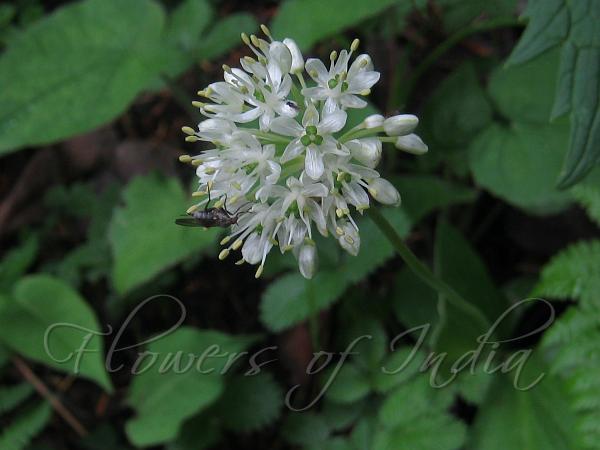
|
Common name: Alpine Leek, Victory onion • Hindi: Pangari
Botanical name:  Allium victorialis Family: Alliaceae (Onion family) Allium victorialis Family: Alliaceae (Onion family)
Synonyms: Cepa victorialis, Allium plantagineum, Allium anguinum
Alpine Leek is interesting onion-like plant, with cylindrical bulb 4-6 cm long, coat net-veined, fibrous. Leaves are 3-6, stalked, broadly lanceshaped to elliptic, 10-20 cm long, 4-6 cm broad, shorter than the flowering stem. Flowers are borne in an umbel, atop a long leafless stem. Flower-stalks are 1-2 cm long. Tepals are white to yellow-white, 5 mm long, oblong, pointed to blunt. Filaments are longer than the tepals, entire, outer narrower, subulate, inner broader, lanceshaped. Style is protruding. Seeds are almost spherical. Bulb is eaten raw or cooked, as sn onion substitute. The plants are as pungent as garlic. The bulbs are rather small, about 1-2 cm in diameter, and are produced in clusters on a short rhizome. Leaves are eaten raw or cooked. The stems and leaves are eaten, they are much favoured in Japan. Flowers are eaten raw or cooked. The juice of the plant is used as a moth repellent. The whole plant is said to repel insects and moles. Alpine Leek is found in the Himalayas, C. Asia and E. Asia, at altitudes of 600-2500 m. Flowering: June-August.
Medicinal uses:  The root is antiscorbutic, carminative, diuretic and vermifuge. Used in the treatment of profuse menstruation. The root is antiscorbutic, carminative, diuretic and vermifuge. Used in the treatment of profuse menstruation.
Himalaya Onion
|  |
|

|
Common name: Himalaya Onion, Jimbur
Botanical name: Allium wallichii Family: Alliaceae (onion family)
Himalaya Onion is a deciduous bulb that grows to 1.0 meters high by 0.5 meters wide. It grows in Himalyan foothills between 2300-6600 m. It sports hemispheric umbels of purple flowers. In Nepal, Himalaya onion is often used for cooking, especially for flavouring dal (दाल) boiled legumes. Rather uniquely, jimbu leaves are usually employed in the dried state and fried in butter fat to develop their flavour.
Medicinal uses:  The bulbs, boiled then fried in ghee, are eaten in the treatment of cholera and dysentery. The raw bulb is chewed to treat coughs and colds. It is said that eating the bulbs can ease the symptoms of altitude sickness. Members of this genus are in general very healthy additions to the diet. They contain sulphur compounds (which give them their onion flavour) and when added to the diet on a regular basis they help reduce blood cholesterol levels, act as a tonic to the digestive system and also tonify the circulatory system. The bulbs, boiled then fried in ghee, are eaten in the treatment of cholera and dysentery. The raw bulb is chewed to treat coughs and colds. It is said that eating the bulbs can ease the symptoms of altitude sickness. Members of this genus are in general very healthy additions to the diet. They contain sulphur compounds (which give them their onion flavour) and when added to the diet on a regular basis they help reduce blood cholesterol levels, act as a tonic to the digestive system and also tonify the circulatory system.
Milk and Wine Lily
|  |
|
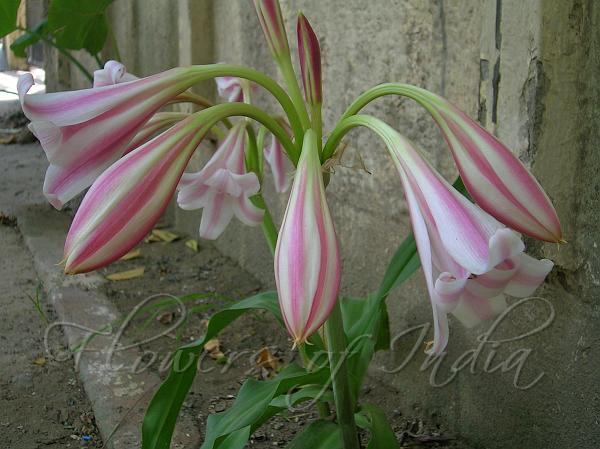
|
Common name: Milk and Wine Lily, Ceylon swamplily, Pink striped trumpet lily • Hindi: सुदर्शन Sudarshan • Marathi: Gandani-kanda, Gadambhikanda, Golkamdo • Tamil: Vishamungil • Kannada: Vish mungli • Bengali: Sukhdarshan • Konkani: Golkando • Sanskrit: मधुपर्णिका Madhuparnika, Vrishakarni
Botanical name:  Crinum latifolium Family: Amaryllidaceae (Nargis family) Crinum latifolium Family: Amaryllidaceae (Nargis family)
Synonyms: Crinum cochinchinense, Crinum longistylum, Crinum esquirolii
This old fashioned crinum lily is a low maintence plant that produces lovely, large, striped, lily-like flowers. The stripes are alternately wine pink and white. The flowers also have a wonderful faintly sweet fragrance. The tall bloom stalk stands about 18-24 inches above the abundant foilage and hold 5+ blooms at a time! These will produce several flower stalks during the warmer months with the majority of blooms coming in the spring and fall. These lilies will multiply by producing bulbs underground as well as from the seeds that form after the blooms. You'll have a lovely large group of these in no time. Milk and Wine Lily is native to India. Flowering: June-August.
Medicinal uses:  Bulbs are extremely acrid. When roasted, they are used as a rubefacient in rheumatism. Crushed and toasted bulb is applied to piles and abscesses to cause suppuration. The juice of the leaf is used in earache. Bulbs are extremely acrid. When roasted, they are used as a rubefacient in rheumatism. Crushed and toasted bulb is applied to piles and abscesses to cause suppuration. The juice of the leaf is used in earache.
Garden Asparagus
|  |
|
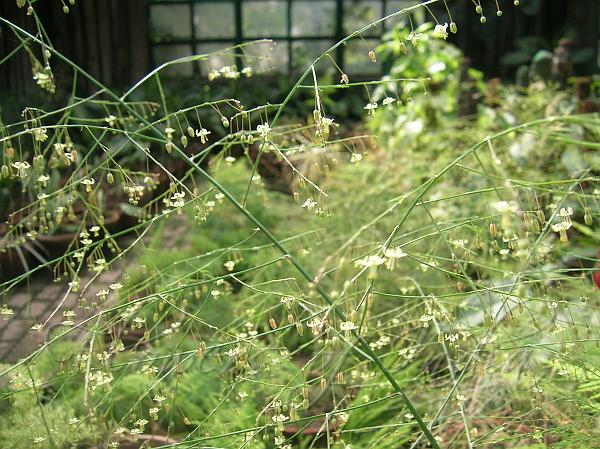
|
Common name: Asparagus, Garden asparagus
Botanical name: Asparagus officinalis Family: Asparagaceae (Asparagus family)
Asparagus is believed to be native to the east Mediterranean and the Middle East. It thrives along sandy riverbanks, shores of lakes and wet, salty coastal areas. It is very salt tolerant. Today it grows “wild” across many of the areas around the world where it is grown for food. Asparagus grows into a tall upright bush. It’s hard to say what the asparagus flower means. It’s totally discrete. Hard to see, hard to study. Flowers are small, with two yellowish-green rings of petal-like tepals. Still, the asparagus flower is looked fro by the bees, the asparagus being honey-bearing. The leaves of the asparagus are even harder to define. They can’t even remind of what usually defines a plant. The leaves barely have the shape of scales.
Medicinal uses:  Vegetable eaten raw or boiled, the asparagus has surprising medicinal properties. The asparagus is indicated in some general illnesses like asthenia, anemia, rheumatism, diabetes as well as renal lithiasis. It is firstly a fortifier. From the asparagus offshoots decoction, juice, syrup and tincture are prepared. Very often used is the asparagus juice, a preparation practically accessible to anyone. Vegetable eaten raw or boiled, the asparagus has surprising medicinal properties. The asparagus is indicated in some general illnesses like asthenia, anemia, rheumatism, diabetes as well as renal lithiasis. It is firstly a fortifier. From the asparagus offshoots decoction, juice, syrup and tincture are prepared. Very often used is the asparagus juice, a preparation practically accessible to anyone.
Satawari
|  |
|
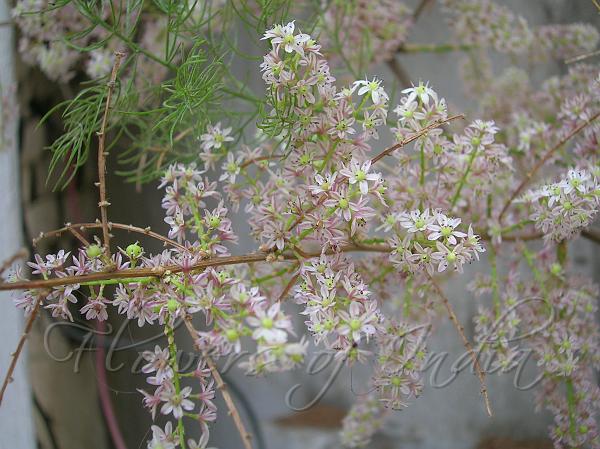
|
Common name: Satawari, Wild Asparagus • Hindi: सतावरी satawari, bojhidan, शतवीर shatavir •Manipuri: নুংগাৰৈ Nunggarei • Marathi: सतावरी मूल Satavari-mul, आसवेल Asvel • Tamil: ஸதாவரீ Sadavari, Tannir-muttan-kizhangu, கிலவரீ Kilavari • Malayalam: ചതവലീ Chatavali, സതവലീ Satavali • Telugu: challa-gaddalu, challagadda, ettavaludutige • Kannada: aheruballi, ashadhi, halarru-makkal • Bengali: সতমুলী Satamuli, সতমূল Satamul • Oriya: ବରୀ Vari • Urdu: ستاور Satawar, شقاقل مسری Shaqaqul misri • Assamese: সতোমূল Satomul • Sanskrit: Abhiru, शतावरी Shatavari, हिरण्यस्रिंगी Hiranyasringi • Mizo: Arkebawk
Botanical name: Asparagus racemosus Family: Asparagaceae (Asparagus family)
Synonyms: Asparagus volubilis
Satawari is a woody climber growing to 1-2 m in height, with leaves like pine needles, small and uniform and the flowers white, in small spikes. It contains adventitious root system with tuberous roots. Stems are climbing, branched, up to 2 m; branches usually distinctly striate-ridged. Leaves are just modified stems, called cladodes. Branches contain spines on them. Inflorescences develope after cladodes, axillary, each a many-flowered raceme or panicle 1-4 cm. Pedicel 1.5-3 mm, slender, articulate at middle. Flowers are white with a pink tinge, 2-3 mm, bell-shaped with 6 petals. Stamens equal, ca. 0.7 mm; anthers yellow, minute. Within India, it is found growing wild in tropical and sub-tropical parts of India including the Andamans; and ascending in the Himalayas up to an altitude of 1500 m. Flowering: October-November.
Medicinal uses:  In Ayurvedic medicine, the root of Satavari is used in the form of juice, paste, decoction and powder to treat intrinsic haemorrhage, diarrhoea, piles, hoarseness of voice, cough, arthritis, poisoning, diseases of female genital tract, erysipelas, fever, as aphrodisiac and as rejuvinative. In Ayurvedic medicine, the root of Satavari is used in the form of juice, paste, decoction and powder to treat intrinsic haemorrhage, diarrhoea, piles, hoarseness of voice, cough, arthritis, poisoning, diseases of female genital tract, erysipelas, fever, as aphrodisiac and as rejuvinative.
Identification credit: Nandan Kalbag
Satawari
|  |
|
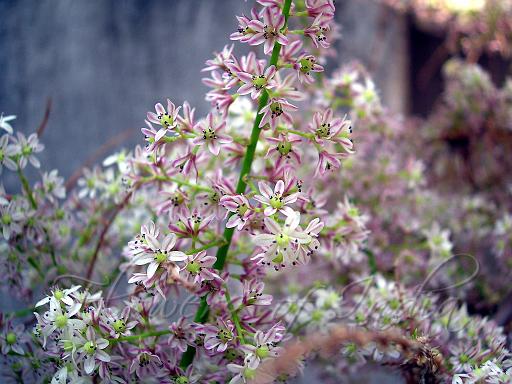
|
Common name: Satawari, Wild Asparagus • Hindi: सतावरी satawari, bojhidan, शतवीर shatavir •Manipuri: নুংগাৰৈ Nunggarei • Marathi: सतावरी मूल Satavari-mul, आसवेल Asvel • Tamil: ஸதாவரீ Sadavari, Tannir-muttan-kizhangu, கிலவரீ Kilavari • Malayalam: ചതവലീ Chatavali, സതവലീ Satavali • Telugu: challa-gaddalu, challagadda, ettavaludutige • Kannada: aheruballi, ashadhi, halarru-makkal • Bengali: সতমুলী Satamuli, সতমূল Satamul • Oriya: ବରୀ Vari • Urdu: ستاور Satawar, شقاقل مسری Shaqaqul misri • Assamese: সতোমূল Satomul • Sanskrit: Abhiru, शतावरी Shatavari, हिरण्यस्रिंगी Hiranyasringi • Mizo: Arkebawk
Botanical name: Asparagus racemosus Family: Asparagaceae (Asparagus family)
Synonyms: Asparagus volubilis
Satawari is a woody climber growing to 1-2 m in height, with leaves like pine needles, small and uniform and the flowers white, in small spikes. It contains adventitious root system with tuberous roots. Stems are climbing, branched, up to 2 m; branches usually distinctly striate-ridged. Leaves are just modified stems, called cladodes. Branches contain spines on them. Inflorescences develope after cladodes, axillary, each a many-flowered raceme or panicle 1-4 cm. Pedicel 1.5-3 mm, slender, articulate at middle. Flowers are white with a pink tinge, 2-3 mm, bell-shaped with 6 petals. Stamens equal, ca. 0.7 mm; anthers yellow, minute. Within India, it is found growing wild in tropical and sub-tropical parts of India including the Andamans; and ascending in the Himalayas up to an altitude of 1500 m. Flowering: October-November.
Medicinal uses:  In Ayurvedic medicine, the root of Satavari is used in the form of juice, paste, decoction and powder to treat intrinsic haemorrhage, diarrhoea, piles, hoarseness of voice, cough, arthritis, poisoning, diseases of female genital tract, erysipelas, fever, as aphrodisiac and as rejuvinative. In Ayurvedic medicine, the root of Satavari is used in the form of juice, paste, decoction and powder to treat intrinsic haemorrhage, diarrhoea, piles, hoarseness of voice, cough, arthritis, poisoning, diseases of female genital tract, erysipelas, fever, as aphrodisiac and as rejuvinative.
Identification credit: Nandan Kalbag
Cabbage Palm
|  |
|
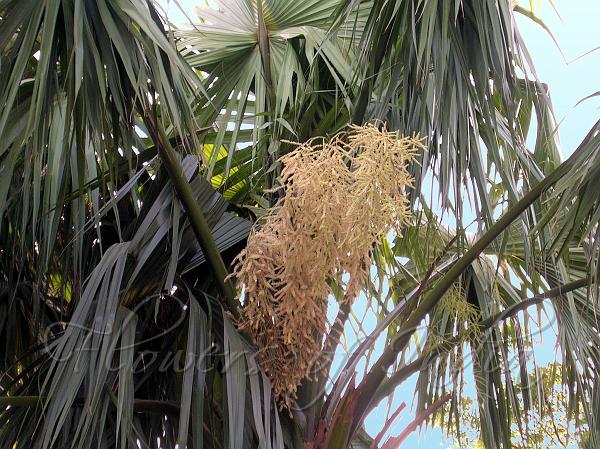
|
Common name: Sabal palm, palmetto palm, cabbage palm • Manipuri: কোনা Kona
Botanical name: Sabal palmetto Family: Arecaceae (Palm family)
Cabbage palm is a beautiful and versatile palm, is hence quite popular. It is recognized by its tan-gray, unbranched trunk, and large crown with fanlike leaves. The large leaves have a dull finish and are a medium green, sometimes yellow-green, in color depending on the individual and situation. Each leaf is up to 12 ft long overall including the spineless petioles (leaf stems) which measure about 5-6 ft in length. Leaves emerge directly from the trunk which is often covered with old leaf stem bases that are arranged in an interesting criss-cross pattern. Depending on the individual these may persist to the ground even in very old palms. Cabbage palm grows to a height of 10 - 25 m (32-82 feet), with a stem diameter of approximately 30 - 60 cm. In mid-summer the cabbage palm bears creamy white flowers on a long branched inflorescence that is held completely within the crown. Flowers are followed in late fall or early winter by black and fleshy spherical fruit that is about one third of an inch in diameter.
Medicinal uses:  Roots are cooling, restorative. Juice of plant is diuretic, stimulant, antiphlegmatic, useful in dropsy. Cabbage palm is native to the Americas. Roots are cooling, restorative. Juice of plant is diuretic, stimulant, antiphlegmatic, useful in dropsy. Cabbage palm is native to the Americas.
Grass of the Dew
|  |
|

|
Common name: Grass of the Dew
Botanical name: Cyanotis arachnoidea Family: Commelinaceae (Dayflower family)
Synonyms: Cyanotis bodinieri
Grass of the Dew plant has furry violet blooms, dotted with yellow stamens. It is a perennial her with fibrous roots. Main stem is undeveloped, short. Fertile stems arise from below the leaf rosette, diffuse, creeping, 20-80 cm. Leaves are in a basal rosette and cauline. Rosulate leaf blade linear, 8-35 × 0.5-1.5 cm; cauline leaf blade on fertile stems much shorter, to 7 cm, abaxially rather densely arachnoid. Flowers arise in often several, both terminal and axillary heads, stalkless or on a stalk up to 4 cm. Bracts are 7-8 mm. Sepals are fused at base, linear-lanceshaped, about 5 mm, webby on the underside. Petals are blue-purple, blue, or white, about 6 mm. Filaments are blue, cobweb-like. Capsules are broadly oblong, trigonous, about 2.5 mm, densely hairy at the tip. Flowering: June-September.
Medicinal uses:  Grass of the Dew was used to cure the rheumatic infections in the China Imperial. The roots are used as medicine for stimulating blood circulation, as a muscle and joint relaxant, and for relieving rheumatoid arthritis. Grass of the Dew was used to cure the rheumatic infections in the China Imperial. The roots are used as medicine for stimulating blood circulation, as a muscle and joint relaxant, and for relieving rheumatoid arthritis.
Arrow Leaf Pondweed
|  |
|
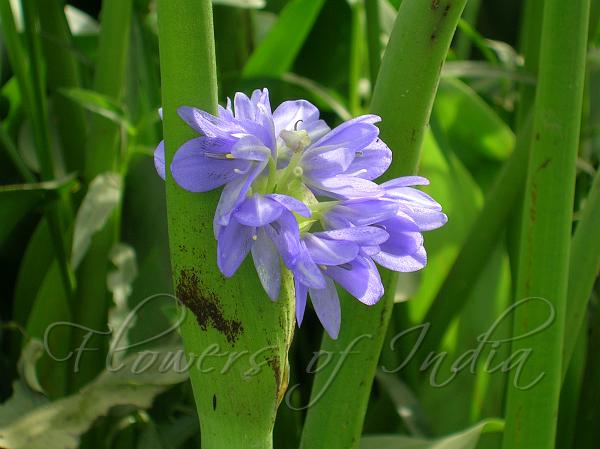
|
Common name: Arrow Leaf Pondweed, arrow-leaf monochoria, hastate-leaf pondweed, monochoria •Hindi: लौंकिया Launkia • Bengali: Nukha
Botanical name: Monochoria hastata Family: Pontederiaceae (Pickerel weed family)
Arrow-leaf Pondweed is an emergent aquatic herb with stems approximately 0.7-1.2 m long. The basal leaves are arrow-shaped. The inflorescence of 25- 60 flowers is in a dense spike 6-9 cm long. The flowers are 13-16 mm long, purple or whitish. One anther is coloured blue, c. 6 mm long, the other 5 anthers are yellow and c. 4 mm long. The seed capsule is 7 mm long, and 5-6 mm diameter. This species occurs in India, Sri Lanka and SE Asia, extending to New Guinea and Australia. Arrow-leaf Pondweed is often grown as an ornamental in water gardens, and the entire plant except its roots is eaten in India. Flowering: March–June.
Medicinal uses:  Plant is considered alterative, tonic and cooling. Juice of leaves is applied to boils. Rhizomes are powdered with charcoal and used for scurf. Plant is considered alterative, tonic and cooling. Juice of leaves is applied to boils. Rhizomes are powdered with charcoal and used for scurf.
Oval Leaf Pondweed
|  |
|
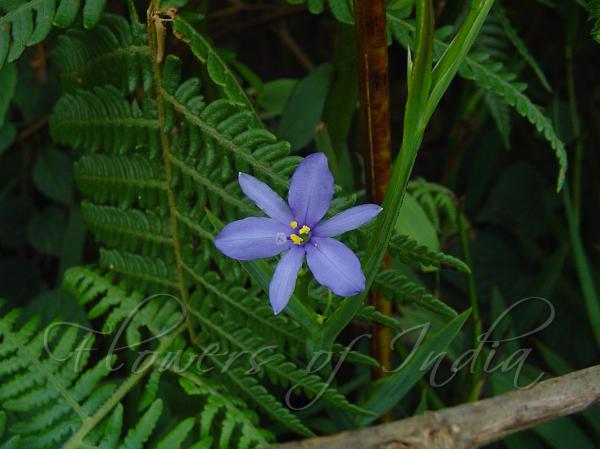
|
Common name: Oval Leaf Pondweed, Oval Leaf Monochoria, Marshy betelvine • Hindi: ननका Nanka, इंदीवर Indivar • Marathi: Nelat-phal • Tamil: Karimkuvalam • Malayalam: Karinkuvvalam • Telugu: Nirakancha • Kannada: Neelothpala • Bengali: nukha • Assamese: nara meteka • Sanskrit: इंदीवरः Indivarah
Botanical name: Monochoria vaginalis Family: Pontederiaceae (Pickerel weed family)
Oval Leaf Pondweed is an attached aquatic annual or perennial herb with emersed leaves, to 50 cm tall. More widespread than M. hastata, it is a serious weed of rice fields. Leaves variable - 2-12.5 cm long, 0.5-10 cm wide, in very young plants without lamina; leaves of somewhat older plants with a floating linear or lanceolate blade; leaves of still older plants, ovate-oblong to broadly ovate, sharply acuminate, the base heart-shaped or rounded, shiny, deep green in color. Inflorescence spikelike, basally opposite the sheath of the floral leaf, with a large bract arising from a thickened bundle on leaf stalk, about two-thirds of the way up the stalk from the base. Flowers 3-25, opening simultaneously or in quick succession, on pedicels 4-25 mm long. Petals six, violet or lilac blue, spreading at flowering, afterwards spirally contorted. As is typical of many aquatic annuals, plant size, leaf shape, and flower number are highly variable in relation to the amount of water. The entire plant (except the roots) is eaten as a vegetable in India, and the roots are used medicinally. Flowering: August-March.
Medicinal uses:  Oval Leaf Pondweed is used in Ayurvedic, Unani and folklore medicine. The root is used for toothache and the bark is eaten with sugar for asthma. Oval Leaf Pondweed is used in Ayurvedic, Unani and folklore medicine. The root is used for toothache and the bark is eaten with sugar for asthma.
Painted Spiral Ginger
|  |
|
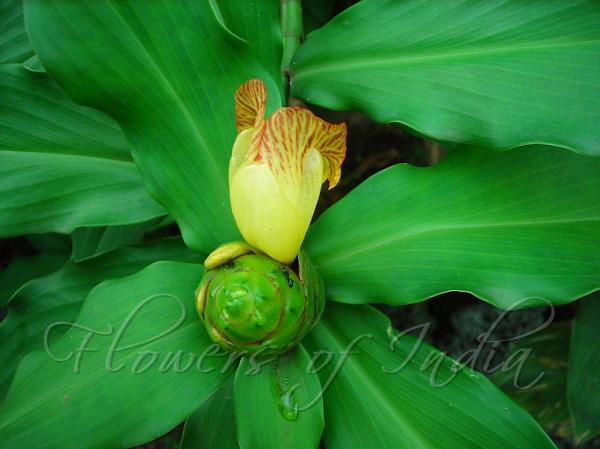
|
Common name: Painted Spiral Ginger, Spotted Spiral Ginger
Botanical name: Costus pictus Family: Costaceae (Spiral Ginger family)
Synonyms: Costus hieroglyphica, Costus mexicanus, Costus congestus
Painted Spiral Ginger is a perennial herb, native to Mexico. It has long narrow leaves with a characteristic wavy edges. The bases of the sheaths are mottled with markings that have earned the plant the synonym of Costus hieroglyphica. The inflorescences form both at the end of a leafy stem, and less often radically on a short nearly leafless stem. Painted Spiral Ginger can be recognized by its yellow flowers with red spots and stripes. In India it is grown in gardens as ornamental plant especially in Kerala in every home. The major attraction of this plant is its stem with spiral leaves and light airy and tissue paper like flowers. Red painted stem enhances the beauty of the glossy leaves and strongly spiralling canes.
Medicinal uses:  The Costus pictus is valued mainly for its tonic, stimulant and antiseptic properties. It is said to be aphrodisiac and to be able to prevent the hair turning grey. Its root is anodyne, antibacterial, antispasmodic, aphrodisiac, carminative, skin, stimulant, stomachic, tonic and vermifuge. The Costus pictus is valued mainly for its tonic, stimulant and antiseptic properties. It is said to be aphrodisiac and to be able to prevent the hair turning grey. Its root is anodyne, antibacterial, antispasmodic, aphrodisiac, carminative, skin, stimulant, stomachic, tonic and vermifuge.
Identification credit: Prashant Awale
Shell Ginger
|  |
|
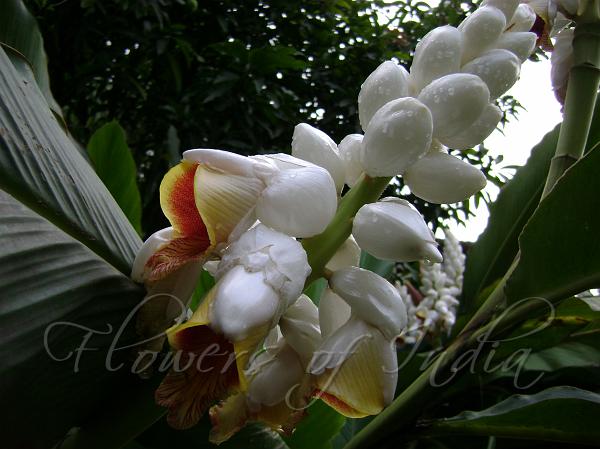
|
Common name: Shell Ginger, Light galangal, Pink porcelain lily • Manipuri: Kanghoo • Bengali: Punnag champa
Botanical name: Alpinia zerumbet Family: Zingiberaceae (Ginger family)
Native to India, Shell ginger is a tall and dramatic landscape or container plant. The leaves are about 2 ft long and 6 in across and strikingly variegated with irregular stripes of green and yellow in some varieties. The habit is upright and does not require staking as do some other members of the ginger family. The flowers are white, tipped in pink, and borne in long pendant arches. In some varieties, there is no pink in the tip. The individual flowers are reminiscent of small seashells, which accounts for the common name "shell ginger".Typically, shell ginger grows to about 6 ft, but it can grow up to 12 ft high.
Medicinal uses:  In Manipur, fresh rhizome is applied to ringworms and other skin diseases. Rhizomes are stimulant, carminative; used in rheumatism and bronchial catarrh. In Manipur, fresh rhizome is applied to ringworms and other skin diseases. Rhizomes are stimulant, carminative; used in rheumatism and bronchial catarrh.
East Indian Arrowroot
|  |
|
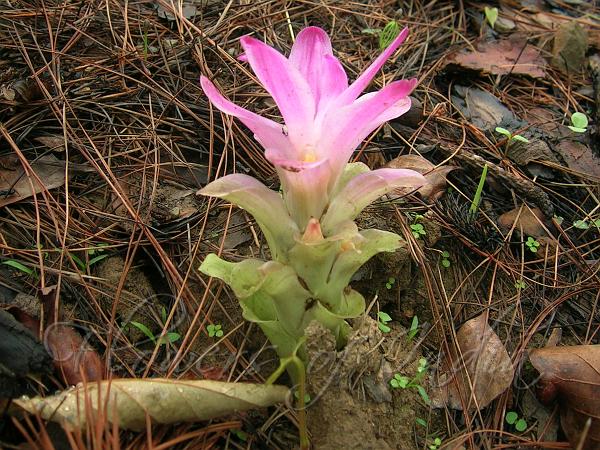
|
Common name: East Indian Arrowroot, Bombay arrowroot • Hindi: Tikhur तिखुर • Bengali: Keturi halodhi • Manipuri: য়াইপন Yaipan • Marathi: Tavakeera, Tavakhira, Tavakila • Malayalam: Koova, Kuva-kizhanna • Tamil: Ararutkilangu, Kua, Ararut-kizhangu • Kannadai: Koove-hittu • Telugu: Ararut-gaddalu •Sanskrit: Tavakshira
Botanical name: Curcuma angustifolia Family: Zingiberaceae (Ginger family)
East Indian Arrowroot is an attractive ginger with stout underground rhizomes which lie dormant in winters. In early spring the flowers are produced before the leaves. Very colourful bracts make this a showy species. The shape and colour of the bracts are very variable. The inflorescence lasts in full bloom on the plants for about three weeks and more. Good for cut flower use with a vase life of 10 days and more for fresh cut blooms. Leaves grow to about 2ft tall and die down in autumn. This species is found in the Eastern Himalays and inhabits bright open hillsides and woods. In Manipur, pakodas made using these flowers, are considered a delicacy.
Medicinal uses:  East Indian Arrowroot is recognized as a medical herb. It is nutritive, and is used as an agreeable, non-irritating diet in certain chronic diseases, during convalescence from fevers, in irritations of the alimentary canal, pulmonary organs, or of the urinary apparatus, and is well suited for infants to supply the place of breast-milk, or for a short time after having weaned them. It may be given in the form of jelly, variously seasoned with sugar, lemon-juice, fruit jellies, essences, or aromatics. Its jelly has no peculiar taste, and is less liable to become acid in the stomach, and is generally preferred by young infants to all others, except tapioca. East Indian Arrowroot is recognized as a medical herb. It is nutritive, and is used as an agreeable, non-irritating diet in certain chronic diseases, during convalescence from fevers, in irritations of the alimentary canal, pulmonary organs, or of the urinary apparatus, and is well suited for infants to supply the place of breast-milk, or for a short time after having weaned them. It may be given in the form of jelly, variously seasoned with sugar, lemon-juice, fruit jellies, essences, or aromatics. Its jelly has no peculiar taste, and is less liable to become acid in the stomach, and is generally preferred by young infants to all others, except tapioca.
Wild Turmeric
|  |
|
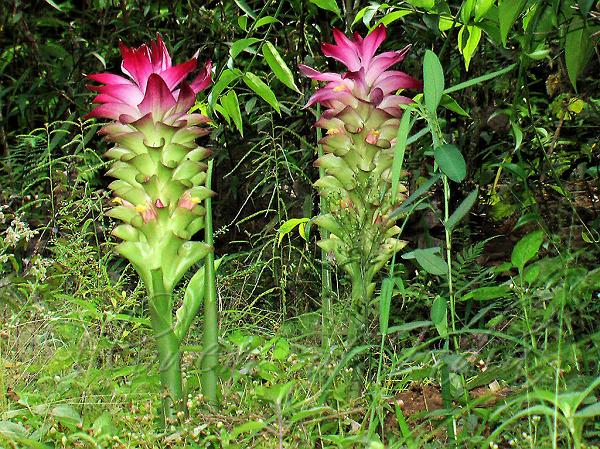
|
Common name: Wild turmeric, Aromatic turmeric • Hindi: Jangli haldi जंगली हळी • Manipuri: লম যাঈঙাঙ Lam Yaingang • Gujarati: Zedoari • Tamil: கஸ்தூதி மஞ்ஜள் Kasturimanjal • Malayalam: Kattumanna • Telugu: Kasthuri Pasupa • Kannada: Kasthuri Arishina
Botanical name: Curcuma aromatica Family: Zingiberaceae (Ginger family)
Wild tumeric is an aromatic and pretty ginger with stout underground rhizomes. Foliage dies down in late in autumn and the rhizomes remain dormant in winter. The inflorescence appears in early spring from the base of the rhizome. Flowers are pinkish white in color, with an orange lip. The stalk grows to about 8 to 10 inches tall, and is crowned with enlarged colored bracts tipped with pink. Leaves appear after the flowers. When in full growth the plants can reach a height of about 3ft tall. Leaves are broad and very decorative, elliptic, 3-4 ft long, and 20 cm wide, leaf-stalk being as long as the blade. Good for cut-flower use with a vase life of about 10 days for a fresh stem. This species is found in the eastern Himalayas and inhabits warm forest areas. Grows fast and vigorously during the summer monsoon months. Rhizomes used to a limited extent in villages for flavouring curries.
Medicinal uses:  Wild turmeric is recognized as a medical herb with strong antibiotic properties. It is believed to play a role in preventing and curing cancer in chinese medicine. In an effort to remove cell accumulations such as a tumors, curcuma is often utilized. There are two species commonly used in cancer therapy that, like ginger, have a spicy taste.It contains aromatic volatile oils that help to remove excessive lipids from the blood, reduce aggregation of platelets (sticking of the blood cells to form masses), and reduce inflammation. Wild turmeric is recognized as a medical herb with strong antibiotic properties. It is believed to play a role in preventing and curing cancer in chinese medicine. In an effort to remove cell accumulations such as a tumors, curcuma is often utilized. There are two species commonly used in cancer therapy that, like ginger, have a spicy taste.It contains aromatic volatile oils that help to remove excessive lipids from the blood, reduce aggregation of platelets (sticking of the blood cells to form masses), and reduce inflammation.
Black Turmeric
|  |
|
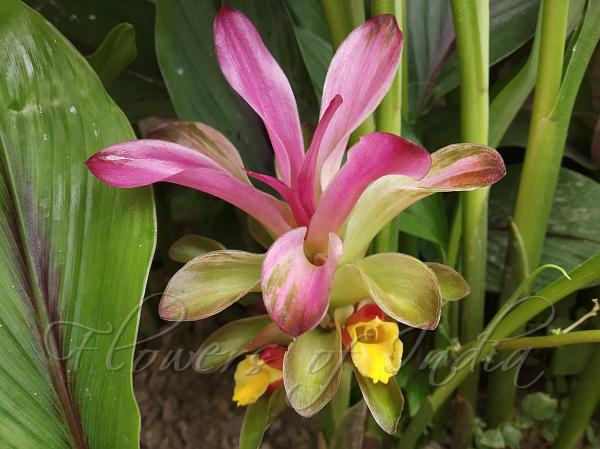
|
Common name: Black Turmeric • Hindi: काली हल्दी Kali Haldi, Nar Kachura, कृष्ण केदार Krishna kedar •Manipuri: যাঈঙাঙ অমূবা Yaingang Amuba • Marathi: काला हल्दी Kala-haldi • Telugu: Nalla Pasupu, Manupasupu • Kannada: kariarishina, naru kachora • Bengali: Kala haldi • Mizo: Aihang, Ailaihang •Assamese: kala haladhi • Nepali: कालो हलेदो Kaalo haledo
Botanical name: Curcuma caesia Family: Zingiberaceae (Ginger family)
Black Turmeric is a perennial herb with bluish-black rhizome, native to North-East and Central India. The leaves have a deep violet-red patch which runs through the length of the lamina. Usually, the upper side of the leaf is rough, velvety, but this character may vary. Flowering bracts are green with a ferruginous tinge. Flower petals may be deep pink or red in color. The rhizome is bitter, hot taste with pungent smell. Black Turmeric is used in Tantrik Sadhana. The dried leaves are used as a source for fuel. Northern tribes use Black Turmeric as a talisman to keep the evil spirits away. Presently Black Turmeric is on the verge of extinction.
Medicinal uses:  Claimed to be useful in treating Piles, Leprosy, Bronchitis, Asthma, Cancer, Epilepsy, Fever, Wounds, Impotency, Fertility, Menstrual disorders, tooth ache, vomiting etc. Claimed to be useful in treating Piles, Leprosy, Bronchitis, Asthma, Cancer, Epilepsy, Fever, Wounds, Impotency, Fertility, Menstrual disorders, tooth ache, vomiting etc.
Turmeric
|  |
|

|
Common name: Turmeric • Assamese: হালধি, Halodhi • Bengali: হলুদ Halud • Gujarati: હળદર Haldar •Hindi: हल्दी Haldi • Kannada: Arishina, Arisina • Malayalam: മഞ്ഞള്, Manjal • Marathi: हळद Halad •Nepali: हल्दी Haldi • Oriya: Haladi • Sanskrit: Haridra, Marmarii • Tamil: மஞ்சள் Manjal • Telugu: హరిద్ర, Haridra • Urdu: Haldi, ہلدی
Botanical name: Curcuma longa Family: Zingiberaceae (Ginger family)
Turmeric is a rhizomatous herb, native to tropical South Asia. Turmeric is a very important spice in India, which produces nearly the whole world’s crop and uses 80% of it. The plant grows to a height of 3-5 ft. It has oblong, pointed leaves and bears funnel-shaped yellow flowers, peeping out of large bracts. The rhizome is the portion of the plant used medicinally. It is usually boiled, cleaned, and dried, yielding a yellow powder. Dried Turmeric root is the source of the spice turmeric, the ingredient that gives curry powder its characteristic yellow color. Turmeric is used extensively in foods for both its flavor and color. Turmeric has a long tradition of use in the Chinese and Ayurvedic systems of medicine.
Hill Turmeric
|  |
|
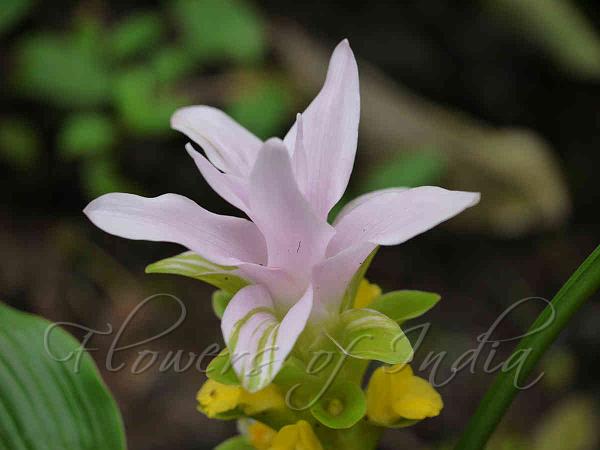
|
 |  ative ative |  |
| Photo: Venugopalan Cheriyaveettil |
|
Common name: Hill Turmeric • Hindi: Kachura • Marathi: रानहळद raan halada, शिंदळवान shindalavana or शिंदळवानी shindalavani • Tamil: Kattu manjal • Malayalam: Kattu manjal
Botanical name: Curcuma pseudomontana Family: Zingiberaceae (Ginger family)
Hill Turmeric is an erect herb, growing to 75 cm tall, found on moist, shaded areas of wet forests and along sluggish grassy slopes of higher altitude. It has stout rootstock bearing small almond like sub-globose tubers at the ends of the_fibrous roots. The tubers are fleshy and white inside, aromatic. Leaves 3-5, oblong-lancelike, 20-30 x 6-9 cm, base acute, tip sharp, margin entire, hairless; shiny; leaf stalk and the leaf sheath up to 20 cm long. Flowering spikes seen in the center of the previously formed tuft of leaves, 10-25 cm long, bearing numerous compactly arranged flowers; flowering bracts conspicuous, inverted eggshaped to lancelike, 3-5 x l.5-2,cm, apex rounded to acute, hairless; gr,een with a pinktip. Non-flowering bracts (coma) oblong-lancelike, conspicuous, purple below and pinkish purple above. Flowers 2-4 in each fertile bract, bright yellow, 3 cm long and 4 cm broad. Capsules spherical, splitting by 3-valves, smooth. Seeds ovoid or oblong, usually covered with arils. Flowering: June-Septermber.
Medicinal uses:  The Savara tribes in the Eastern Ghats of Andhra Pradesh use tuber extracts to cure jaundice. Jatapu and Kaya tribes apply warm tuber paste to treat body swellings. Women of Jatapu and Savara tribes eat boiled tubers to increase lactation. Khand tribes apply tuber paste on the head for cooling effect. The Savara tribes in the Eastern Ghats of Andhra Pradesh use tuber extracts to cure jaundice. Jatapu and Kaya tribes apply warm tuber paste to treat body swellings. Women of Jatapu and Savara tribes eat boiled tubers to increase lactation. Khand tribes apply tuber paste on the head for cooling effect.
Red Ginger Lily
|  |
|
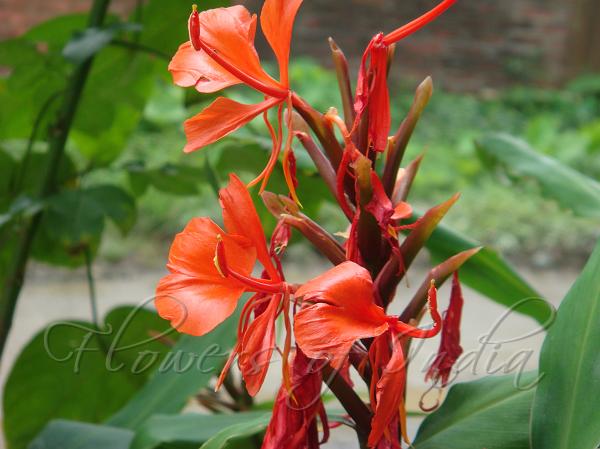
|
Common name: Red Ginger Lily • Manipuri: তখেললৈ অঙাঙ্বা Takhellei angangba
Botanical name: Hedychium marginatum Family: Zingiberaceae (Ginger family)
Red Ginger Lily is a very uncommon ginger with beautiful bright red flowers. In form, the flowers look similar to those of Butterfly Ginger Lily. Flowers appear in spikes. It is found in NE India, particularly Manipur.
Medicinal uses:  Decoction of rhizomes is given in bronchitis and stomach complaints. Decoction of rhizomes is given in bronchitis and stomach complaints.
Spiked Ginger Lily
|  |
|
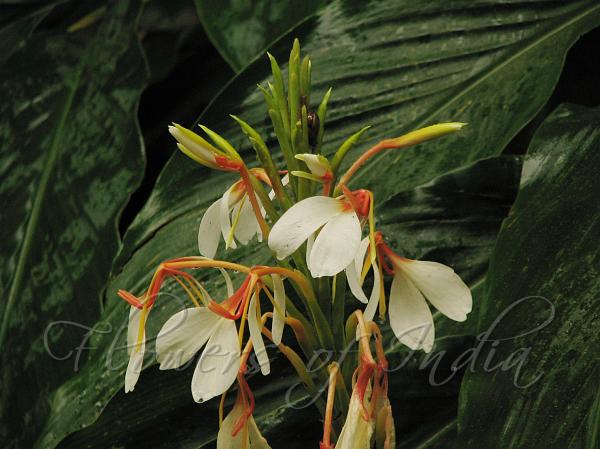
|
Common name: Spiked Ginger Lily • Hindi: Sandharlika संधार्लिका , Kapur kachri कपूर कचरी • Manipuri: তখেল্লৈ Takhellei • Nepali: सेतो सरो Seto saro
Botanical name: Hedychium spicatum Family: Zingiberaceae (Ginger family)
Spiked Ginger Lily is a smallish hardy ginger, growing to around 1-1.5 m, with leafy stems. Flowers are fragrant, white with an orange-red base, appearing in a dense spike, 15-25 cm, at the top of the stem. Flower tube is 5-6.5 cm long, much longer than the sepal cup, with white narrow petals spreading outwards. Lip is white with two elliptic lobes with an orange base. Filaments of the stamens are red. Leaves are oblong, up to a foot long and 4-12 cm broad, much like Haldi leaves. A perfume Abeer is obtained from the root stock. Spiked Ginger Lily is found from Himachal Pradesh to Arunachal Pradesh, at altitudes of 1800-2800 m. Flowering: July-August.
Medicinal uses:  Rootstocks are used in medicine. Rootstocks are used in medicine.
Shampoo Ginger
|  |
|
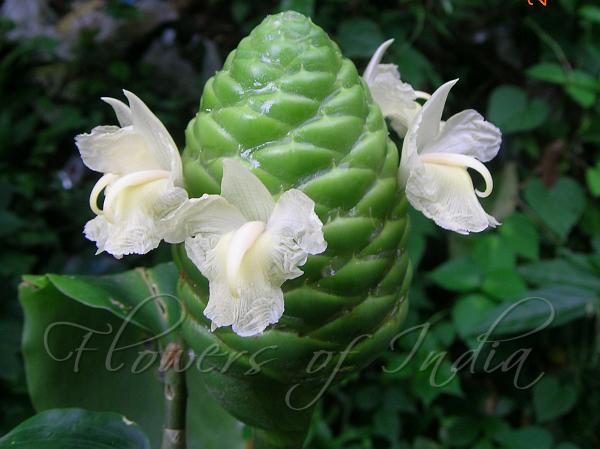
|
Common name: Shampoo Ginger, Pinecone ginger • Assamese: gathian • Bengali: kulanjan, mahabari bach, narkachur • Hindi: बनअदरक Banadrak, Mahabari-bach, Nar-kachur • Kannada: agale shunti •Malayalam: kathu-inshi-kua • Manipuri: যাইমু Yaimu • Marathi: काली हळद Kaali halad, narakchora • Oriya: viranam • Sanskrit: ahava, avanti, karpuraharidra • Tamil: araniyacaranai • Telugu: kaarallamu • Urdu: Kapur kachri کپورکچری
Botanical name:  Zingiber zerumbet Family: Zingiberaceae (Ginger family) Zingiber zerumbet Family: Zingiberaceae (Ginger family)
Synonyms: Amomum zerumbet, Zerumbet zingiber, Amomum silvestre
Shampoo Ginger is a perennial herb characterized by pinecone-like heads of bracts from which white flowers emerge. On maturity the heads turns bright red and exude a wonderfully thick liquid with an equally wonderful fragrance. And, in fact, the liquid makes an excellent shampoo, thus its common name Shampoo Ginger. The 10-12 elliptic-lanceshaped leaves, 15-20 cm long, grow in an alternate arrangement on thin, upright stem. Among the leafy stems the conical or club-shaped flower heads form on separate and shorter stalks. These appear in the summer, after the leafy stems have been growing for awile. The flower heads are reddish-green 3-10 cm long with overlapping scales, enclosing small yellowish-white flowers that poke out a few at a time. The flowers are inconspicuous, 3-petaled, and creamish in color. The flower stalks usually remain hidden beneath the leaf stalks. This plant, originating in India, was distributed eastward through Polynesia and introduced to the Hawaiian Islands in the canoes of early Polynesian settlers. Shampoo Ginger grows in moist, shaded, forested areas.
Medicinal uses:  In Hawaii the spicy-smelling fresh rhizomes were pounded and used as medicine for indigestion and other ailments. In traditional use, the rhizome was ground in a stone mortar with a stone pestle, was mixed with a ripe Noni fruit and then used to treat severe sprains. The pulp was placed in a cloth and loosely bound around the injured area. For a toothache or a cavity, the cooked and softened rhizome was pressed into the hollow and left for as long as was needed. To ease a stomach ache, the ground and strained rhizome material is mixed with water and drunk. In Hawaii the spicy-smelling fresh rhizomes were pounded and used as medicine for indigestion and other ailments. In traditional use, the rhizome was ground in a stone mortar with a stone pestle, was mixed with a ripe Noni fruit and then used to treat severe sprains. The pulp was placed in a cloth and loosely bound around the injured area. For a toothache or a cavity, the cooked and softened rhizome was pressed into the hollow and left for as long as was needed. To ease a stomach ache, the ground and strained rhizome material is mixed with water and drunk.
Umbrella Sedge
|  |
|

|
Common name: Umbrella Sedge, Nutgrass, Nutsedge, Purple Nutsedge • Hindi: नागरमोथा Nagarmotha • Marathi: lawala • Tamil: koraikkilangu, nakamuttakkacu • Malayalam: korakizhanna • Telugu: kolatungamuste, tungagaddalaveru • Kannada: konnarigadda, nagarmusthe • Urdu: Nagarmotha, Sadkofi • Sanskrit: chakranksha, charukesara, chudalapindamusta, kachharuha, kalapini, nadeyi, nagar-mustaka
Botanical name: Cyperus scariosus Family: Cyperaceae (Sedge family)
Umbrella Sedge is a perennial herb, about a meter tall, arising from rhizomes and tubers. The stems are 3-sided and triangular in cross section and there is an umbrella-like tuft of long narrow leaves at the top. The leaves are yellow to green in color with a distinct ridge. The plant has red-brown flower spikelets with up to 40 individual flowers. The dried tuberous roots are collected, dried and used in traditional medicine. Nutgrass is used in hair - and skin care products. It stimulates sebaceous glands near hair roots. Also interesting is that the oil, an amber viscous liquid, extracted from this plant is used in perfumery.
Medicinal uses:  The tubers are credited with astringent, diaphoretic, diuretic, dessicant, cordial and stomachic properties. A decoction of the tuber is used for washing hair, treating gonorrhea and syphilis. It is also given in diarrhea and for general weakness. The tubers are credited with astringent, diaphoretic, diuretic, dessicant, cordial and stomachic properties. A decoction of the tuber is used for washing hair, treating gonorrhea and syphilis. It is also given in diarrhea and for general weakness.
Crowfoot Grass
|  |
|
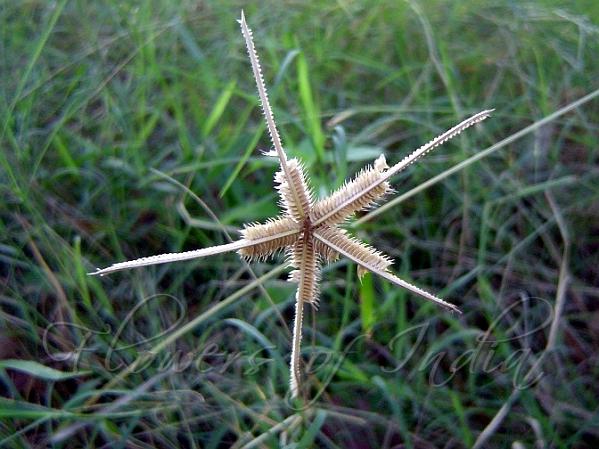
|
Common name: Crowfoot Grass, beach wiregrass, coast button grass, comb fringe grass, Duck grass, Durban crowfoot, Egyptian fingergrass, Egyptian grass, finger comb grass, four-finger grass • Hindi: मकड़ा Makra • Manipuri: পুঙফাঈ Pungphai
Botanical name: Dactyloctenium aegyptium Family: Poaceae (Grass family)
Synonyms: Eleusine aegyptiaca
Crowfoot Grass is a slender to moderately robust, spreading annual herb, with wiry stems, that bend and root at the lower nodes, with tips that may rise to about 2 ft in height. It is a very common weed of open spaces and wasteland. Leaves are typically grass-like,2-30 cm long, 2-9 mm wide, with blades and sheaths that are without hair. Leaf margins have long, stiff hairs. Flowers arise in 1-7 spikes, 1-6.2 cm long, 3-7 mm wide, at the tip of stems. Seed head resembles a crow's foot, hence the common name. Crowfoot Grass is native to Africa, but naturalized world-wide.
Medicinal uses:  In Manipur, juice of fresh plants is prescribed in fevers. Decoction of the plant is given in small pox. In Manipur, juice of fresh plants is prescribed in fevers. Decoction of the plant is given in small pox.
|
|
|
|
|
|
|
|
|
|
|
|
|
|
|
|
|
|
|
|
|
|
|
|
|
|
|
|
|
|
|
|
|
|
|
|
|
|
|
|
|
|
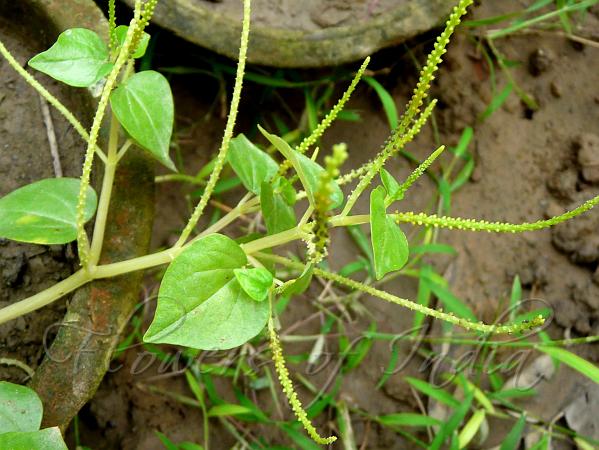
 In South America, Shiny Bush is used medicinally. A solution of the fresh juice of stem and leaves is used against eye inflammation. It is also been applied against coughing, fever, common cold, headache, sore throat, diarrhea, against kidney - and prostate problems and against high blood pressure. Shiny bush is also used in Ayurvedic medicine
In South America, Shiny Bush is used medicinally. A solution of the fresh juice of stem and leaves is used against eye inflammation. It is also been applied against coughing, fever, common cold, headache, sore throat, diarrhea, against kidney - and prostate problems and against high blood pressure. Shiny bush is also used in Ayurvedic medicine


























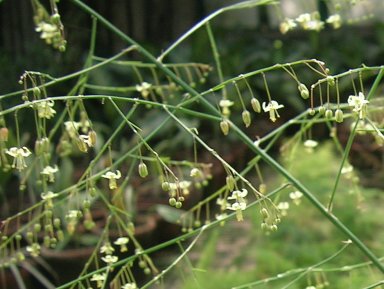





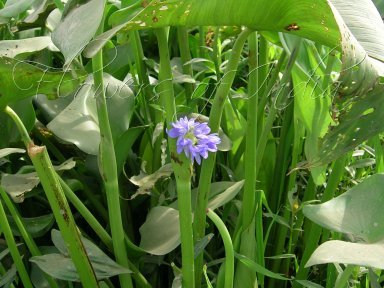













No comments:
Post a Comment